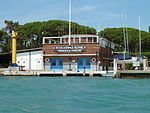Venice International University

Venice International University (VIU) is an international center for higher education and research located on the island of San Servolo, in Venice, Italy. It was established on December 15, 1995 as a consortium of five Universities and two Italian Institutions. Since its foundation, Venice International University has grown to include a total of twenty members (as of 2020), in collaboration and with support of the Metropolitan City of Venice, Italy (Italian: Città metropolitana di Venezia). Boston College of the United States Duke University of the United States Ludwig Maximilian University of Munich, Germany (German: Ludwig-Maximilians-Universität) Tel Aviv University of Israel Korea University, Seoul, Republic of Korea Tsinghua University of Beijing, China Ca' Foscari University of Venice, Italy (Italian: Università Ca' Foscari Venezia) University IUAV of Venice, Italy (Italian: Università IUAV di Venezia) European University at Saint Petersburg, Russia Waseda University of Tokyo, Japan University of Padua, Italy (Italian: Università degli Studi di Padova) University of Bordeaux, France National Research Council (Italy) University of Lausanne, Switzerland Institut National de la Recherche Scientifique of Quebec City, Canada (English: National Institute of Scientific Research) University of Rome Tor Vergata, Italy (Italian: Università degli Studi di Roma "Tor Vergata") KU Leuven of Belgium. (Dutch: Katholieke Universiteit Leuven) Stellenbosch University, South Africa University of Exeter, United Kingdom University of Ljubljana, Slovenia
Excerpt from the Wikipedia article Venice International University (License: CC BY-SA 3.0, Authors, Images).Venice International University
Viale Vittorio Veneto, Venice Venezia-Murano-Burano
Geographical coordinates (GPS) Address External links Nearby Places Show on map
Geographical coordinates (GPS)
| Latitude | Longitude |
|---|---|
| N 45.418611111111 ° | E 12.357222222222 ° |
Address
Venice International University
Viale Vittorio Veneto
30132 Venice, Venezia-Murano-Burano
Veneto, Italy
Open on Google Maps










